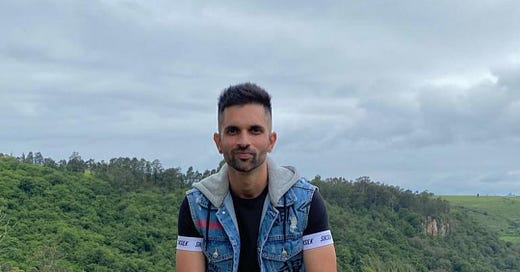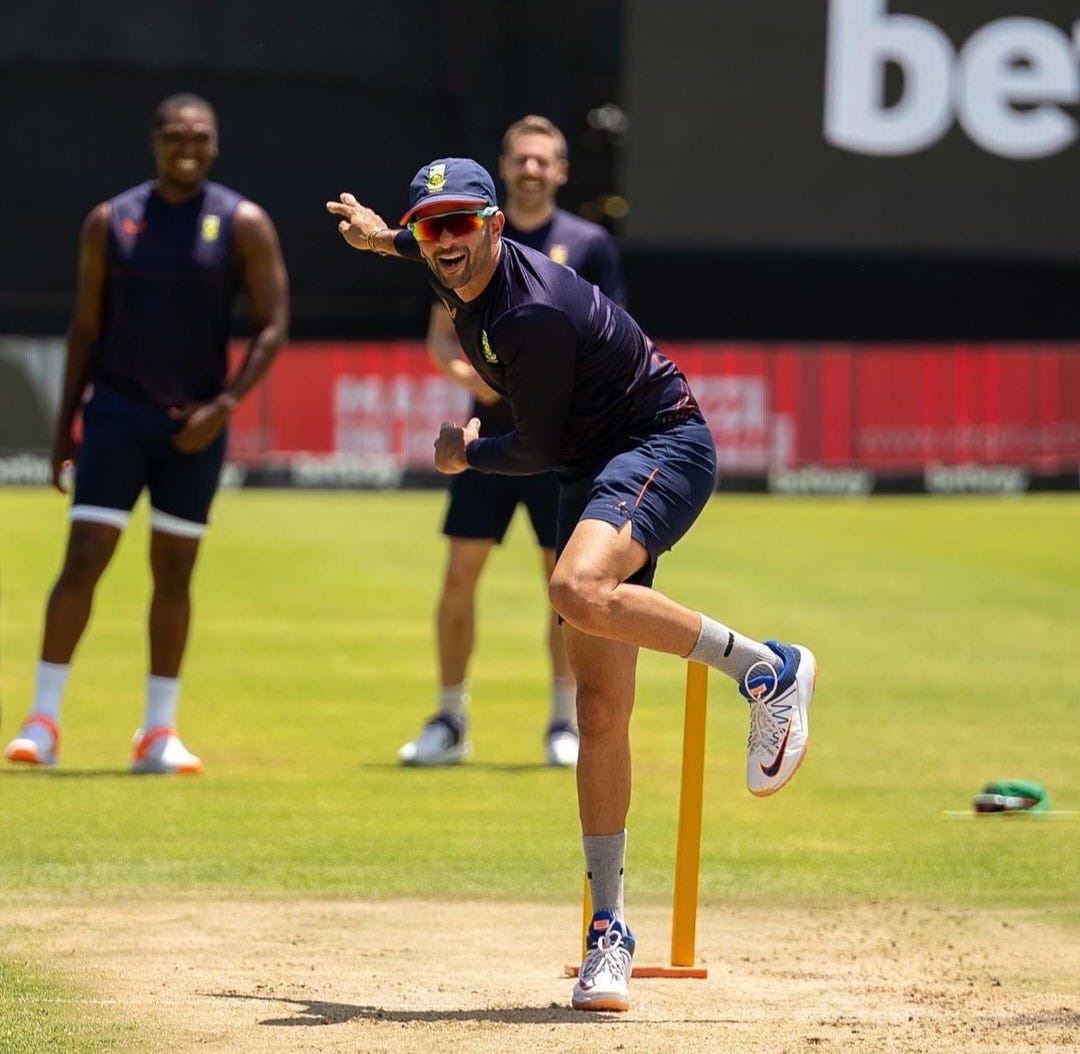Maharaj's Coming of Age Season
2013 was Keshav Maharaj's eclosion year. He emerged from his cocoon ready to take on the world.
Keshav Maharaj is second after Imran Tahir on the list of spinners with the most wickets for South Africa across all formats. He might not overtake Tahir, but he has a shot at overtaking Hugh Tayfield as the spinner with the most Test wickets for South Africa. He is 12 wickets away. He is also the second South African spinner to take a hat trick in Test cricket.
His enduring dream has always been to make a name for himself in a country that produces phenomenal fast bowlers. One year put him firmly on course.
Keshav Maharaj's bags were packed. They were by the door, literally. His passport was ready. He was excited. Maharaj had never lived alone. This would be the first time he had to take care of himself in a strange country. His mother fussed over him as if he was about to go to war.
Going to play cricket was a lifelong dream for Maharaj since the day his father bought him his first English willow bat. "I had always wanted in the UK, from when my father bought that bat for me. It had a special place in my heart," says Maharaj.
Maharaj is a creature of habit and does not like altering his routines unless he absolutely has to. Despite his excitement, Maharaj remained true to his daily schedule. After he left school, his father, Athmanand, dropped Maharaj at Kingsmead Stadium every day on his way to work in the morning and picked him up in the afternoon. That routine remained unaltered as the day drew closer. The Maharaj men were so consistent that you could set your watch to their comings and goings.
In the nets, Maharaj wouldn't let go of the ball. Maharaj was the resident spin-bowling net bowler because of his omnipresence in the nets. When he was not bowling to Dolphins players needing a net, Maharaj could be found bowling at cones.
Days before Maharaj left, Lance Klusener interrupted the spinner's session for a chat. Maharaj invested more time than anyone into his bowling, an admirable trait. But, he carried more weight than anyone in the team, an undesirable trait. To identify Maharaj, one only had to look for the chubby guy. Klusener felt it was time to talk to the young spinner about his weight.
"He was a talented kid. Good work ethic and is a wonderful spin bowler. But his weight was a problem. Sometimes he was overlooked because of it," says Klusener. Klusener first met Maharaj when he was fresh out of school. When they were not together at Dolphins, they played against each other at club cricket. "Playing against Klusener and Dale Benkenstein at club level really helped me develop as a bowler. I still play club cricket."
No one had ever raised the issue of weight with Maharaj. But, just as he knew that there were people who compared him to his father, he knew he was different - not in a good way. His teammates didn't say anything about the way he looked. They didn't have to. In sports circles, teammates and the opposition will cast judgement your way when you don't look the part. It didn't help that Maharaj often failed yo-yo tests and other things.
He was self-conscious and ashamed of his appearance, so much so that he didn't change in the changing room with everyone else. He always wandered into the bathroom to change. With the ball in hand, Maharaj had Shane Warne's swag. "I have always studied what great sportspeople do, and from a young age, I loved watching Shane Warne and how he outsmarted batters," says Maharaj.
This newsletter is completely reader-supported. If you’re willing and able, please consider supporting it in one of two ways, leaving a tip or becoming a Patreon. Thank you so much for your time and investment!
Without a ball in hand, Maharaj had the confidence of a fat kid surrounded by athletic and fit jocks at the beach. According to Klusener, Maharaj couldn't run, catch or field. Most teams hide their less athletic fielders at areas like short third or short fine leg, and they do a decent job. Maharaj was not even one of those players, he always seemed visibly afraid of the ball coming to him when fielding.
"He had talent. He could bowl. You would sit and watch and think, 'What a waste of talent,'" says Klusener. "It was frustrating to watch because it didn't look like he was going anywhere with his talent."
In his poem Crush, Canadian poet Shane Koyczan speaks of a 10-year-old version of himself fantasizing about a near-annihilation of their town as his only chance at getting a date with his crush.
It was your typical love story
‘School is attacked by zombie dinosaurs,
And the shy kid saves the day.' - Koyczan recites.
Maharaj's fantasy involved wishing his teammates ill fortune. "One season, the team signed two new spinners. Instead of working harder to remain competitive, I began to wish they didn't do well in matches so that I could get a chance. It's not a good place to be as an athlete," says Maharaj.
Klusener was worried that Maharaj's bowling alone would not be enough in his capacity as Cuckfield's overseas professional. Generally, overseas pros are expected to win games with the bat, ball and in the field. "I told him he needed to lose 5kgs to give himself a chance, not only in England but as a professional cricketer," says Klusener.
The talk stirred something within Maharaj. It was one of the most serious talks he had ever had concerning his future. Almost overnight, Maharaj went from being the guy who could devour a loaf of bread and coca cola at the drop of a hat to a health-conscious athlete on a no-carbs and no-sugar diet. "I ate more regularly and drank more water," He says.
When he arrived at Cuckfield Cricket Club, Maharaj had also taken up running. In addition to his role as the overseas pro, Maharaj was also a groundsman and was required to be at the Cuckfield Cricket Pavilion daily. Over the next five months, Maharaj ran four kilometres to and from his lodgings to the grounds and back in the mornings and afternoons. "I tried to beat my time by a second every day. Also, because I didn't have a car, I walked everywhere," says Maharaj.
After six weeks, Maharaj had exceeded Klusener's expectations. He had lost 17.5 kgs. His fielding improved, and he also developed an interest in improving his batting. During his time with Cuckfield, Maharaj took 45 wickets in 14 league games at an average of 15.6. He was a new man when he arrived back in South Africa.
Klusener couldn’t hide his pride and excitement when he saw Keshav Maharaj 2.0. “Only 20% of players do what Kesh does. His transformation was an example to others. You want people like him in the team, people who have walked the hard road. They set the standard and are not afraid to walk the talk," says Klusener.
Over the years, Maharaj has gone from being the most unfit player to one of South African cricket's fittest players.
Maharaj was no longer the body-conscious youngster who changed in the bathroom, and he discovered his voice around teammates. He was comfortable sharing advice that players just gathered around him. He no longer wished for misfortune to befall fellow spinners. "I learned a lot from being close to Kesh. He took me under his wing and gave me guidance," says Suneran Muthusamy.
"Losing weight helped me develop better self-esteem. When you have low self-esteem, you become tense and forget to relax when you play. It's limiting,” says Maharaj.
Two years after getting in shape, Maharaj was the leading wicket-taker in 4-Day cricket. In 2016, one of his heroes, Hashim Amla, capped him on a tour to Australia. “I developed goosebumps when Hashim capped me. I still get goosebumps thinking about it. It felt like a dream. I remember the previous night Vernon Philander asked me if I was ready. I told him that I was only there to carry drinks and learn. Vern told me I was playing. I didn’t believe him,” says Maharaj.
The rest, as they say, is history.
If you found this interesting, please share it:
You can support Stumped! by leaving a tip:
Thanks for reading. Until next time… - CS







